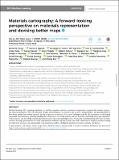Materials cartography: A forward-looking perspective on materials representation and devising better maps
Author(s)
Torrisi, Steven B.; Bazant, Martin Z.; Cohen, Alexander E.; Cho, Min Gee; Hummelshøj, Jens S.; Hung, Linda; Kamat, Gaurav; Khajeh, Arash; Kolluru, Adeesh; Lei, Xiangyun; Ling, Handong; Montoya, Joseph H.; Mueller, Tim; Palizhati, Aini; Paren, Benjamin A.; Phan, Brandon; Pietryga, Jacob; Sandraz, Elodie; Schweigert, Daniel; Shao-Horn, Yang; Trewartha, Amalie; Zhu, Ruijie; Zhuang, Debbie; Sun, Shijing; ... Show more Show less
DownloadPublished version (3.917Mb)
Publisher with Creative Commons License
Publisher with Creative Commons License
Creative Commons Attribution
Terms of use
Metadata
Show full item recordAbstract
Machine learning (ML) is gaining popularity as a tool for materials scientists to accelerate computation, automate data analysis, and predict materials properties. The representation of input material features is critical to the accuracy, interpretability, and generalizability of data-driven models for scientific research. In this Perspective, we discuss a few central challenges faced by ML practitioners in developing meaningful representations, including handling the complexity of real-world industry-relevant materials, combining theory and experimental data sources, and describing scientific phenomena across timescales and length scales. We present several promising directions for future research: devising representations of varied experimental conditions and observations, the need to find ways to integrate machine learning into laboratory practices, and making multi-scale informatics toolkits to bridge the gaps between atoms, materials, and devices.
Date issued
2023-06-01Department
Massachusetts Institute of Technology. Department of Chemical Engineering; Massachusetts Institute of Technology. Department of Mathematics; Massachusetts Institute of Technology. Research Laboratory of Electronics; Massachusetts Institute of Technology. Department of Mechanical Engineering; Massachusetts Institute of Technology. Department of Materials Science and EngineeringJournal
APL Machine Learning
Publisher
AIP Publishing
Citation
Steven B. Torrisi, Martin Z. Bazant, Alexander E. Cohen, Min Gee Cho, Jens S. Hummelshøj, Linda Hung, Gaurav Kamat, Arash Khajeh, Adeesh Kolluru, Xiangyun Lei, Handong Ling, Joseph H. Montoya, Tim Mueller, Aini Palizhati, Benjamin A. Paren, Brandon Phan, Jacob Pietryga, Elodie Sandraz, Daniel Schweigert, Yang Shao-Horn, Amalie Trewartha, Ruijie Zhu, Debbie Zhuang, Shijing Sun; Materials cartography: A forward-looking perspective on materials representation and devising better maps. APL Mach. Learn. 1 June 2023; 1 (2): 020901.
Version: Final published version
ISSN
2770-9019